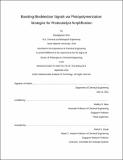| dc.description.abstract | Photopolymerization-based signal amplification (PBA) is a method to enhance biodetection signals by coupling molecular recognition events with photocatalyst labels (eosin Y) and amplifying through visible light-initiated free radical polymerization. Leveraging inherent amplification in the radical polymerization, PBA can provide naked-eye detectable signals within 5 min, showing great potential as a versatile signal amplification platform for rapid point-of-care diagnostic tests. However, the sensitivity of conventional PBA is not sufficient for its extensive use in early diagnosis of diseases. Thus, this thesis focuses on improving the sensitivity of PBA without compromising its short amplification time. To achieve this goal, we sought to investigate the mechanism of eosin Y photoinitiation to understand oxygen consumption processes and identify inefficiencies during the photoinitiation, and then we developed liposome-enhanced PBA to increase the number of target-associated eosin Y per binding event. The knowledge gained from these studies allowed us to develop a new exponential photocatalyst amplification method using photoredox autocatalysis and apply it to PBA.
Through spectroscopic investigations (Chapter 2), we showed that oxygen is consumed stoichiometrically by α-aminoalkyl radical of triethanolamine (TEOA) and reduced eosin Y radical produced during the eosin Y/TEOA photocatalysis. We also identified eosin Y degradation pathways from the reduced eosin Y radical at low oxygen levels. These degradation reactions suggested coupling numerous eosin Y with a specific binding event would be more advantageous to improve the detection limit of PBA.
To increase the number of target-associated eosin Y, we incorporated eosin Y-loaded liposomes into PBA (Chapter 3). Compared to conventional PBA, liposome-enhanced PBA provides 30-fold improvement in sensitivity. However, the extra eosin Y in the monomer solution is still required to suppress oxygen inhibition, limiting the improvement in detection limit. Furthermore, poor thermal stability of the eosin Yloaded liposomes may limit the accessibility of potential diagnostic tests.
To address the issues of liposome-enhanced PBA, we designed an exponential photocatalyst amplification method using photoredox autocatalysis(Chapter 4). In this method, eosin Y, a photocatalyst, amplifies itself by oxidizing a non-fluorescent eosin Y derivative (EYH3─) under green light. The deactivated photocatalyst is stable and rapidly activated under low intensity light, so the eosin Y amplification is suitable for resourcelimited settings. Moreover, we demonstrated that the photocatalyst amplification is compatible with other photochemical reactions and bioassays.
In Chapter 5, we applied the photocatalyst amplification strategy to PBA with sequential red and green light irradiation. Under red light, target-associated methylene blue (MB+ ) activates EYH3─ through photocatalysis without the risk of bulk polymerization. Then, following green light illumination initiates photopolymerization with eosin Y autocatalysis. This approach allowed to remove the extra eosin Y from the monomer solution, improving the detection limit of PBA through the photocatalyst amplification in situ depending on the amount of target-associated methylene blue.
Finally, we consider unexplored research directions to address current limitations in photoinitiation efficiency, dynamic range, and non-specific photocatalyst amplification for further advancing PBA as a versatile signal amplification platform for low-cost, sensitive, and rapid biodetection at the point of care. | |
